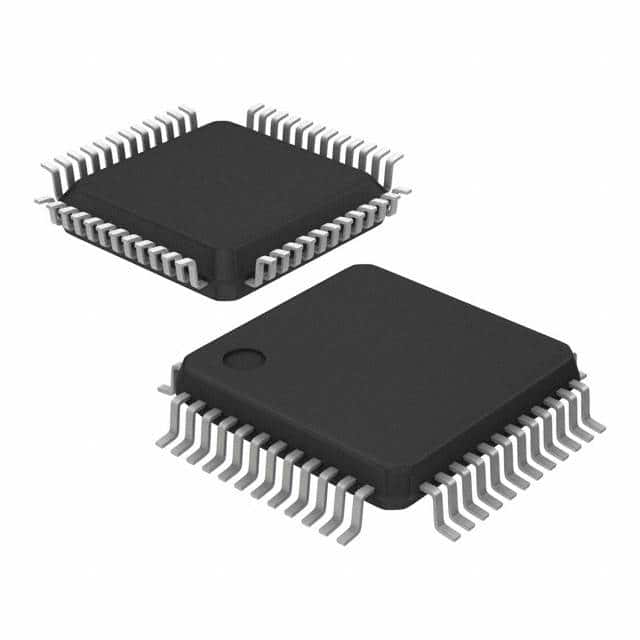Zie specificaties voor productdetails.

TM4C1230H6PMIR
Product Overview
Category: Microcontroller
Use: The TM4C1230H6PMIR is a microcontroller designed for embedded systems and IoT applications. It provides a wide range of features and capabilities to support various electronic projects.
Characteristics: - High-performance ARM Cortex-M4F core - 80 MHz operation frequency - 256 KB Flash memory - 32 KB RAM - Low power consumption - Rich set of peripherals (UART, SPI, I2C, GPIO, etc.) - Real-time clock (RTC) - Analog-to-digital converter (ADC) - Pulse-width modulation (PWM) outputs
Package: The TM4C1230H6PMIR comes in a compact and durable package, making it suitable for use in small form factor devices. The package ensures protection against environmental factors and facilitates easy integration into circuit boards.
Essence: This microcontroller serves as the brain of electronic systems, controlling and coordinating various components and functions. It enables the execution of complex tasks and supports connectivity with other devices.
Packaging/Quantity: The TM4C1230H6PMIR is typically sold in reels or trays, with each reel containing a specific quantity of microcontrollers. The exact quantity may vary depending on the manufacturer's specifications.
Specifications
- Operating Voltage: 3.3V
- Operating Temperature Range: -40°C to +85°C
- Number of Pins: 64
- Clock Speed: 80 MHz
- Flash Memory Size: 256 KB
- RAM Size: 32 KB
- Digital I/O Pins: 42
- Analog Input Pins: 12
- UART Ports: 4
- SPI Ports: 2
- I2C Ports: 2
- PWM Outputs: 8
Detailed Pin Configuration
The TM4C1230H6PMIR microcontroller has a total of 64 pins, each serving a specific purpose. Here is a detailed pin configuration:
- Pin 1: VDD - Power supply voltage
- Pin 2: GND - Ground reference
- Pin 3: PA0 - General-purpose I/O pin
- Pin 4: PA1 - General-purpose I/O pin
- Pin 5: PA2 - General-purpose I/O pin
- Pin 6: PA3 - General-purpose I/O pin
- Pin 7: PA4 - General-purpose I/O pin
- Pin 8: PA5 - General-purpose I/O pin
- Pin 9: PA6 - General-purpose I/O pin
- Pin 10: PA7 - General-purpose I/O pin
- Pin 11: PB0 - General-purpose I/O pin
- Pin 12: PB1 - General-purpose I/O pin
- Pin 13: PB2 - General-purpose I/O pin
- Pin 14: PB3 - General-purpose I/O pin
- Pin 15: PB4 - General-purpose I/O pin
- Pin 16: PB5 - General-purpose I/O pin
- Pin 17: PB6 - General-purpose I/O pin
- Pin 18: PB7 - General-purpose I/O pin
- Pin 19: PC0 - General-purpose I/O pin
- Pin 20: PC1 - General-purpose I/O pin
- Pin 21: PC2 - General-purpose I/O pin
- Pin 22: PC3 - General-purpose I/O pin
- Pin 23: PC4 - General-purpose I/O pin
- Pin 24: PC5 - General-purpose I/O pin
- Pin 25: PC6 - General-purpose I/O pin
- Pin 26: PC7 - General-purpose I/O pin
- Pin 27: PD0 - General-purpose I/O pin
- Pin 28: PD1 - General-purpose I/O pin
- Pin 29: PD2 - General-purpose I/O pin
- Pin 30: PD3 - General-purpose I/O pin
- Pin 31: PD4 - General-purpose I/O pin
- Pin 32: PD5 - General-purpose I/O pin
- Pin 33: PD6 - General-purpose I/O pin
- Pin 34: PD7 - General-purpose I/O pin
- Pin 35: PE0 - General-purpose I/O pin
- Pin 36: PE1 - General-purpose I/O pin
- Pin 37: PE2 - General-purpose I/O pin
- Pin 38: PE3 - General-purpose I/O pin
- Pin
Noem 10 veelgestelde vragen en antwoorden met betrekking tot de toepassing van TM4C1230H6PMIR in technische oplossingen
Sure! Here are 10 common questions and answers related to the application of TM4C1230H6PMIR in technical solutions:
Q: What is TM4C1230H6PMIR? A: TM4C1230H6PMIR is a microcontroller from Texas Instruments' Tiva C Series, specifically designed for embedded applications.
Q: What are the key features of TM4C1230H6PMIR? A: Some key features include a 32-bit ARM Cortex-M4F core, 256KB Flash memory, 32KB RAM, multiple communication interfaces (UART, SPI, I2C), and various peripherals.
Q: What kind of technical solutions can TM4C1230H6PMIR be used for? A: TM4C1230H6PMIR can be used in a wide range of applications such as industrial automation, consumer electronics, Internet of Things (IoT) devices, robotics, and more.
Q: How do I program TM4C1230H6PMIR? A: TM4C1230H6PMIR can be programmed using various development tools like Code Composer Studio (CCS), Keil MDK, or Energia IDE. These tools provide an integrated development environment for writing, compiling, and debugging code.
Q: Can TM4C1230H6PMIR interface with external sensors and actuators? A: Yes, TM4C1230H6PMIR has multiple GPIO pins that can be used to interface with external sensors and actuators. It also supports various communication protocols like I2C, SPI, and UART for interfacing with other devices.
Q: Does TM4C1230H6PMIR support real-time operating systems (RTOS)? A: Yes, TM4C1230H6PMIR is compatible with popular RTOS like FreeRTOS and TI-RTOS. These operating systems provide task scheduling, inter-task communication, and other features to facilitate real-time applications.
Q: Can TM4C1230H6PMIR communicate wirelessly? A: TM4C1230H6PMIR does not have built-in wireless capabilities. However, it can be paired with external modules like Wi-Fi or Bluetooth transceivers to enable wireless communication.
Q: What kind of power supply does TM4C1230H6PMIR require? A: TM4C1230H6PMIR typically operates at a voltage range of 2.7V to 3.6V. It can be powered using a regulated power supply or a battery, depending on the application requirements.
Q: Are there any development boards available for TM4C1230H6PMIR? A: Yes, Texas Instruments offers development boards like Tiva C Series LaunchPad that are specifically designed for TM4C1230H6PMIR. These boards provide easy prototyping and debugging capabilities.
Q: Where can I find additional resources and documentation for TM4C1230H6PMIR? A: You can find detailed datasheets, user guides, application notes, and example code on the official Texas Instruments website. Additionally, online forums and communities dedicated to embedded systems can also be helpful for support and learning.

